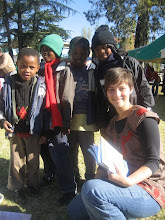While my time in Lesotho can in many ways be summed up by the things I have seen and done and of course the people I have met, one startling absence has made a significant impression on my mind. Evident everywhere are the rich traditions Basotho people hold dear – singing, dancing, drumming, and group celebration. But absent during these wonderful moments is a key demographic, and their lack of attendance drives home for me one of the most simultaneously visible and invisible challenges faced by African people. Where have all the middle-aged people gone?
As a continent, 50% of Africa’s population is currently under the age of fifteen, and Lesotho has one of the highest rates of HIV here and in the wider world. 1 in 4 Basotho people is infected with HIV, and in the 30-40 age bracket that statistic reaches an astonishing 40%. Having seen these numbers on paper in various forms and amalgamations before embarking on my 15-hour plane ride here, they seemed unfathomably large and imposing. But walking the streets and working with families in my neighborhood, I am repeatedly struck by the fact that is not the huge numbers that seem to affect people here the most, but the smaller ones.
Small are the numbers of grandmothers left here, and yet they are responsible for raising their numerous grandchildren orphaned by AIDS. Smaller still are the children who are raising their brothers and sisters in the wake of being orphaned. Few are the resources appropriately allocated either as a result of foreign assistance from governments and corporations abroad or from local governmental agencies. Small and dwindling is the population of middle-aged people, infected with HIV in their twenties and dead by their mid-30s, once the disease has had the 8-10 year run in their bodies necessary to reach complete destructive force. But tiniest of all is the percentage of people receiving suitable ARV (antiretroviral) treatment for their various stages of HIV/AIDS.
And yet. And yet on the street where I live, children play during their holiday breaks. They freely ride shared bicycles up and down dirt roads studded with stones to prevent erosion and put in place by a neighborhood association that collected the money from individual houses. Women hang laundry on backyard lines after they’ve tended their side yard gardens filled with the green leafy vegetable morojo. Inside, babies nap, nestled under piles of blankets to ensure snuggly warmth during a cold winter that doesn’t automatically include indoor heat. Families walk or drive to church on Sunday morning and spend their afternoons together barbecuing and gossiping with friends over a case of cold beer. And yet, life here isn’t all that different from suburbia in the United States. And yet the challenges faced on a daily basis are entirely and utterly foreign to me.
Saturday is the day of funerals here, prepared for on Fridays by groups of neighborhood men and boys who volunteer their time to dig the graves of loved ones and community members. An ex-pat I met on a trip to the mountains last weekend told me, “When you tell a person here that someone has died, they don’t respond the same way they do at home. These people just don’t value life like we do.” And yet Saturday afternoons are filled with agony. Wailing can be heard from the graveyard down the street as groups of neighborhood people troop from one gravesite to another to another. Women collapse on one another in pain, overcome by the thought of one more absence to face. And yet, who in the wide, wide world of global villages and in this small space with large problems, are we to claim that these people don’t grieve, that their absences don’t matter?
Monday, June 29, 2009
Subscribe to:
Post Comments (Atom)


lauren, wow. this post so eloquently describes the personal and communal experience of the worldwide implications of the aids epidemic. your style and ability to write allow these stories to be told and shared.
ReplyDelete